Territorial claims in Antarctica
There are seven sovereign states who have made eight territorial claims in Antarctica: Argentina, Australia, Chile, France, New Zealand, Norway and the United Kingdom. These countries have tended to place their Antarctic scientific observation and study facilities within their respective claimed territories; however, a number of such facilities are located outside of the area claimed by their respective countries of operation, and countries without claims such as India, Italy, Russia and the United States have constructed research facilities within the areas claimed by other countries.
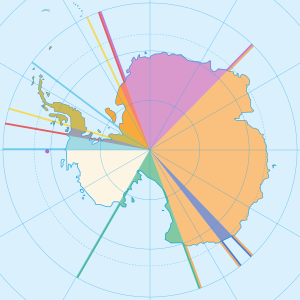
History
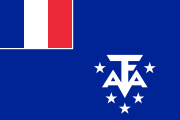
![]()

![]()
.svg.png)
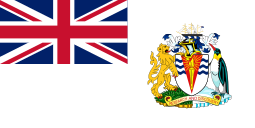
![]()
.svg.png)
![]()


![]()

![]()
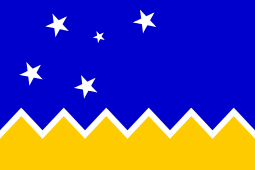
Spanish claims
According to Argentina and Chile, Spain had claims on Antarctica. The capitulación (governorship) granted to the conquistador Pedro Sánchez de la Hoz explicitly included all lands south of the Straits of Magellan (Terra Australis, and Tierra del Fuego and by extension potentially the entire continent of Antarctica). This grant established, according to Argentina and Chile, that an animus occupandi existed on the part of Spain in Antarctica. Spain's sovereignty claim over parts of Antarctica was, according to Chile and Argentina, internationally recognized with the Inter caetera bull of 1493 and the Treaty of Tordesillas of 1494. Argentina and Chile treat these treaties as legal international treaties mediated by the Catholic Church that was at that time a recognized arbiter in such matters.[1] Each country currently has claimed a sector of the Antarctic continent that is more or less directly south of its national antarctic-facing lands.
British claims
The United Kingdom reasserted sovereignty over the Falkland Islands in the far South Atlantic in 1833 and maintained a continuous presence there. In 1908, the British government extended its territorial claim by declaring sovereignty over "South Georgia, the South Orkneys, the South Shetlands, and the (South) Sandwich Islands, and Graham's Land, situated in the South Atlantic Ocean and on the Antarctic continent to the south of the 50th parallel of south latitude, and lying between the 20th and the 80th degrees of west longitude".[2] All these territories were administered as Falkland Islands Dependencies from Stanley by the Governor of the Falkland Islands. The motivation for this declaration lay in the need to regulate and tax the whaling industry effectively. Commercial operators would hunt whales in areas outside the official boundaries of the Falkland Islands and its dependencies, and there was a need to close this loophole.
In 1917, the wording of the claim was modified, so as unambiguously to include all the territory in the sector stretching to the South Pole (thus encompassing all the present British Antarctic Territory). The new claim covered "all islands and territories whatsoever between the 20th degree of west longitude and the 50th degree of west longitude which are situated south of the 50th parallel of south latitude; and all islands and territories whatsoever between the 50th degree of west longitude and the 80th degree of west longitude which are situated south of the 58th parallel of south latitude".[2]
It was the ambition of Leopold Amery, then Under-Secretary of State for the Colonies, that Britain incorporate the entire continent into the Empire. In a memorandum to the governors-general for Australia and New Zealand, he wrote that 'with the exception of Chile and Argentina and some barren islands belonging to France... it is desirable that the whole of the Antarctic should ultimately be included in the British Empire.' The first step was taken on 30 July 1923, when the British government passed an Order in Council under the British Settlements Act 1887, defining the new borders for the Ross Dependency—"that part of His Majesty's Dominions in the Antarctic Seas, which comprises all the islands and territories between the 160th degree of East Longitude and the 150th degree of West Longitude which are situated south of the 60th degree of South Latitude shall be named the Ross Dependency." The Order in Council then went on to appoint the Governor-General and Commander-in Chief of New Zealand as the Governor of the territory.[3]
In 1930, the United Kingdom claimed Enderby Land. In 1933, a British imperial order transferred territory south of 60° S and between meridians 160° E and 45° E to Australia as the Australian Antarctic Territory.[4][5]
Following the passing of the Statute of Westminster in 1931, the government of the United Kingdom relinquished all control over the government of New Zealand and Australia. This however had no bearing on the obligations of the governors-general of both countries in their capacity as Governors of the Antarctic territories.
Other European claims
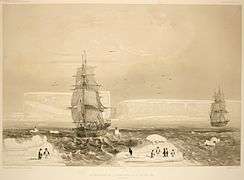
The basis for the claim to Adélie Land by France depended on the discovery of the coastline in 1840 by the French explorer Jules Dumont d'Urville, who named it after his wife, Adèle.[6] He erected the French flag and took possession of the land for France, on January 21, 1840 at 5:30 PM.[7]
The British eventually decided to recognize this claim, and the border between Adélie Land and the Australian Antarctic Territory was fixed definitively in 1938.[8]
These developments also concerned Norwegian whaling interests which wished to avoid British taxation of whaling stations in the Antarctic and felt concern that they would be commercially excluded from the continent. The whale-ship owner Lars Christensen financed several expeditions to the Antarctic with the view to claiming land for Norway and to establishing stations on Norwegian territory to gain better privileges.[9] The first expedition, led by Nils Larsen and Ola Olstad, landed on Peter I Island in 1929 and claimed the island for Norway. On 6 March 1931 a Norwegian royal proclamation declared the island under Norwegian sovereignty[9] and on 23 March 1933 the island was declared a dependency.[10][Notes 2]
The 1929 expedition led by Hjalmar Riiser-Larsen and Finn Lützow-Holm named the continental landmass near the island as Queen Maud Land after the Norwegian queen Maud of Wales.[11] The territory was explored further during the Norvegia expedition of 1930–31.[12] Negotiations with the British government in 1938 resulted in setting the western border of Queen Maud Land at 20°W.[12]
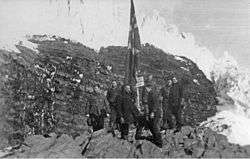
The United States, Chile, the Soviet Union and Germany disputed Norway's claim.[13][14] In 1938 Germany dispatched the German Antarctic Expedition, led by Alfred Ritscher, to fly over as much of it as possible.[12] The ship Schwabenland reached the pack ice off Antarctica on 19 January 1939.[15] During the expedition, Ritscher photographed an area of about 350,000 square kilometres (140,000 sq mi) from the air[16] and dropped darts inscribed with swastikas every 26 kilometres (16 mi). However, despite intensively surveying the land, Germany never made any formal claim or constructed any lasting bases.[17]. Hence, the German Antarctic claim, known as New Swabia, was disputed at the time, and currently is not considered.
On 14 January 1939, five days before the German arrival, Norway annexed Queen Maud Land[11] after a royal decree announced that the land bordering the Falkland Islands Dependencies in the west and the Australian Antarctic Dependency in the east was to be brought under Norwegian sovereignty.[12] The primary aim of the annexation was to secure the Norwegian whaling industry's access to the region.[11][18] In 1948 Norway and the United Kingdom agreed to limit Queen Maud Land to from 20°W to 45°E, and to incorporate the Bruce Coast and Coats Land into Norwegian territory.[12]
South American involvement

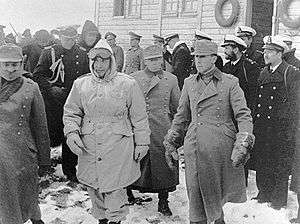
Upon independence in the early 19th century South American nations based their boundaries upon the uti possidetis iuris principle. This meant there was no land without a sovereign. Chile and Argentina applied this to Antarctica citing the Inter caetera bull of 1493 and the Treaty of Tordesillas of 1494. Argentina and Chile treat these treaties as legal international treaties mediated by the Catholic Church that was in that time a recognized arbiter in these matters.[1]
This encroachment of foreign powers was a matter of immense disquiet to the nearby South American countries, Argentina and Chile. Taking advantage of a European continent plunged into turmoil with the onset of the Second World War, Chile's president, Pedro Aguirre Cerda, declared the establishment of a Chilean Antarctic Territory in areas already claimed by Britain.
Argentina has a long history in the area.[19] In 1904 the Argentine government began a permanent occupation of one of the Antarctic islands with the purchase of a meteorological station on Laurie Island established in 1903 by Dr William S. Bruce's Scottish National Antarctic Expedition. Bruce offered to transfer the station and instruments for the sum of 5.000 pesos, on the condition that the government committed itself to the continuation of the scientific mission.[20] The Envoy at the British Legation in Argentina, William Haggard[21], also sent a note to the Argentine Foreign Minister, José A. Terry, ratifying the terms of Bruce's proposition.[20]
In 1906, Argentina communicated to the international community the establishment of a permanent base in the South Orkney Islands, the Orcadas Base. However, Haggard responded by reminding Argentina that the South Orkneys were British. The British position was that Argentine personnel was granted permission only for the period of one year. The Argentine government entered into negotiations with the British in 1913 over the possible transfer of the island. Although these talks were unsuccessful, Argentina attempted to unilaterally establish their sovereignty with the erection of markers, national flags and other symbols.[22].
In response to this and earlier German explorations, the British Admiralty and Colonial Office launched Operation Tabarin in 1943 to reassert British territorial claims against Argentinian and Chilean incursion and establish a permanent British presence in the Antarctic.[23] The move was also motivated by concerns within the Foreign Office about the direction of United States post-war activity in the region.
A suitable cover story was the need to deny use of the area to the enemy. The Kriegsmarine was known to use remote islands as rendezvous points and as shelters for commerce raiders, U-boats and supply ships. Also, in 1941, there existed a fear that Japan might attempt to seize the Falkland Islands, either as a base or to hand them over to Argentina, thus gaining political advantage for the Axis and denying their use to Britain.
In 1943, British personnel from HMS Carnarvon Castle[24] removed Argentine flags from Deception Island. The expedition was led by Lieutenant James Marr and left the Falkland Islands in two ships, HMS William Scoresby (a minesweeping trawler) and Fitzroy, on Saturday January 29, 1944.
Bases were established during February near the abandoned Norwegian whaling station on Deception Island, where the Union Flag was hoisted in place of Argentine flags, and at Port Lockroy (on February 11) on the coast of Graham Land. A further base was founded at Hope Bay on February 13, 1945, after a failed attempt to unload stores on February 7, 1944. Symbols of British sovereignty, including post offices, signposts and plaques were also constructed and postage stamps were issued.
Operation Tabarin provoked Chile to organise its First Chilean Antarctic Expedition in 1947–48, where the Chilean president Gabriel González Videla personally inaugurated one of its bases.[25]
Following the end of the war in 1945, the British bases were handed over to civilian members of the newly created Falkland Islands Dependencies Survey (subsequently the British Antarctic Survey), the first such national scientific body to be established in Antarctica.
Postwar developments
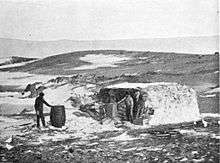
Friction between Britain and Argentina continued into the postwar period. Royal Navy warships were dispatched in 1948 to prevent naval incursions. The only instance of shots fired in anger on Antarctica occurred in 1952 at Hope Bay, when staff at British Base "D" (established 1945) came up against the Argentine team at Esperanza Base (est. 1952), who fired a machine gun over the heads of a British Antarctic Survey team unloading supplies from the John Biscoe. The Argentines later extended a diplomatic apology, saying that there had been a misunderstanding and that the Argentine military commander on the ground had exceeded his authority.
The United States became politically interested in the Antarctic continent before and during WWII. The United States Antarctic Service Expedition, from 1939–1941, was sponsored by the government with additional support from donations and gifts by private citizens, corporations and institutions. The objective of the Expedition, outlined by President Franklin D. Roosevelt, was to establish two bases: East Base, in the vicinity of Charcot Island, and West Base, in the vicinity of King Edward VII Land. After operating successfully for two years but with international tensions on the rise, it was considered wise to evacuate the two bases.[26] However, immediately after the war, American interest was rekindled with an explicitly geopolitical motive. Operation Highjump, from 1946-1947 was organised by Rear Admiral Richard E. Byrd Jr. and included 4,700 men, 13 ships, and multiple aircraft. The primary mission of Operation Highjump was to establish the Antarctic research base Little America IV,[27] for the purpose of training personnel and testing equipment in frigid conditions and amplifying existing stores of knowledge of hydrographic, geographic, geological, meteorological and electromagnetic propagation conditions in the area. The mission was also aimed at consolidating and extending United States sovereignty over the largest practicable area of the Antarctic continent, although this was publicly denied as a goal even before the expedition ended.
Towards an international treaty

Meanwhile, in an attempt at ending the impasse, Britain submitted an application to the International Court of Justice in 1955 to adjudicate between the territorial claims of Britain, Argentina, and Chile. This proposal failed, as both Latin American countries rejected submitting to an international arbitration procedure.[28]
Negotiations towards the establishment of an international condominium over the continent first began in 1948, involving the 8 claimant countries: Britain, Australia, New Zealand, U.S.A., France, Norway, Chile and Argentina. This attempt was aimed at excluding the Soviet Union from the affairs of the continent and rapidly fell apart when the USSR declared an interest in the region, refused to recognize any claims of sovereignty and reserved the right to make its own claims in 1950.[28]
An important impetus toward the formation of the Antarctic Treaty System in 1959 was the International Geophysical Year (IGY), 1957–1958. This year of international scientific cooperation triggered an 18-month period of intense Antarctic science. More than 70 existing national scientific organisations then formed IGY committees, and participated in the cooperative effort. The British established Halley Research Station in 1956 by an expedition from the Royal Society. Sir Vivian Fuchs headed the Commonwealth Trans-Antarctic Expedition, which completed the first overland crossing of Antarctica in 1958. In Japan, the Japan Maritime Safety Agency offered ice breaker Sōya as the South Pole observation ship and Showa Station was built as the first Japanese observation base on Antarctica.
France contributed with Dumont d'Urville Station and Charcot Station in Adélie Land. The ship Commandant Charcot of the French Navy spent nine months of 1949/50 at the coast of Adélie Land, performing ionospheric soundings.[29] The US erected the Amundsen–Scott South Pole Station as the first permanent structure directly over the South Pole in January 1957.[30]
Finally, to prevent the possibility of military conflict in the region, the United States, United Kingdom, the Soviet Union, and 9 other countries with significant interests negotiated and signed the Antarctic Treaty in 1959. The treaty entered into force in 1961 and sets aside Antarctica as a scientific preserve, established freedom of scientific investigation, and banned military activity on that continent. The treaty was the first arms control agreement established during the Cold War.[31]
Antarctic territorial claims

Seven sovereign states had made eight territorial claims to land in Antarctica south of the 60° S parallel before 1961. None of these claims have an indigenous population.
All claim areas are sectors with the exception of Peter I Island. The South Orkney Islands fall within the territory claimed by Argentina and the United Kingdom, and the South Shetland Islands fall within the areas claimed by Argentina, Chile, and the United Kingdom.
These claims have been recognized only between (some of) the seven claiming states. The UK, France, Australia, New Zealand and Norway all recognize each other's claims[32] (none of their claims overlap with each other).
Prior to 1962, the British Antarctic Territory was a dependency of the Falkland Islands and also included South Georgia and the South Sandwich Islands. The Antarctic areas became a separate overseas territory following the ratification of the Antarctic Treaty. South Georgia and the South Sandwich Islands remained a dependency of the Falkland Islands until 1985 when they too became a separate overseas territory.
Official claims south of 60° S
| Flag | Territory | Claimant | Date | Claim limits/Coordinates | Area (km2) | |
|---|---|---|---|---|---|---|
| Adélie Land (District of the French Southern and Antarctic Lands) |
1840 | – | 432,000 | |||
| Argentine Antarctica (Department of Tierra del Fuego, Antarctica, and South Atlantic Islands Province) |
1904 | – | 1,461,597 | |||
| Australian Antarctic Territory (External Territory of Australia) |
1933 | – – |
5,896,500 | |||
| British Antarctic Territory (British Overseas Territory) |
1908 | – | 1,709,400 | |||
| Chilean Antarctic Territory (Commune of Antártica Chilena Province) |
1940 | – | 1,250,257.6 | |||
| Queen Maud Land (Dependency of Norway) |
1939 | – | 2,700,000 | |||
| Peter I Island (Dependency of Norway) |
1931 | 68°51′S 90°35′W | 154 | |||
| Ross Dependency (Dependency of New Zealand) |
1923 | – | 450,000 | |||
| Total | 13,899,908.6 | |||||
Overlapping claims
|
Unclaimed
| ||||||||||||||||
Official claims of Antarctic islands north of 60° S
Four island territories on the Antarctic Plate located north of the 60° South circle of latitude are associated with the continent of Antarctica. They are not subject to the Antarctic Treaty System. None of these territories has an indigenous population.




Another island territory, partly located on the Sandwich Plate and partly on the Scotia Plate,[Notes 4] is sometimes associated with the continent of Antarctica (since both of those are minor tectonic plates that border the major Antarctic Plate).
Possible future claims
There has been speculation about possible future claims. The United States and Russia (as a successor state of the Soviet Union) maintain they have reserved the right to make claims. There has also been speculation on Brazil making a claim bounded by 53° W and 28° W,[33] thus overlapping with the Argentine and British claims but not with the Chilean claim. Peru made a reservation of its territory rights under the principle of Antarctic defrontation (in Spanish) and due to influence on its climate, ecology and marine biology, adducing, in addition, geological continuity and historical links.[34]
Uruguayan adhesion to the Antarctic Treaty System includes a declaration in that it reserves its rights in Antarctica in accordance with international law.[35]
In 1967, Ecuador declared its right over an area bounded by 84°30' W and 95°30' W, thus overlapping with the Chilean claim and Norway's claim of Peter I Island. The claim was ratified in 1987.[36]
Antarctic Treaty
The Antarctic Treaty and related agreements regulate international relations with respect to Antarctica, Earth's only continent without a native human population. The Treaty has now been signed by 48 countries, including the United Kingdom, the United States, and the now-defunct Soviet Union. The Treaty set aside Antarctica as a scientific preserve, established freedom of scientific investigation and banned military activity on that continent. This was the first arms control agreement established during the Cold War.
The Antarctic Treaty states that contracting to the treaty:
- is not a renunciation of any previous territorial claim
- does not affect the basis of claims made as a result of activities of the signatory nation within Antarctica
- does not affect the rights of a State under customary international law to recognise (or refuse to recognise) any other territorial claim
What the treaty does affect is new claims:
- No activities occurring after 1961 can be the basis of a territorial claim.
- No new claim can be made.
- No claim can be enlarged.
The Soviet Union and the United States both filed reservations against the restriction on new claims,[37] and the United States and Russia assert their right to make claims in the future if they so choose. Brazil maintains the Comandante Ferraz (the Brazilian Antarctic Base) and has proposed a theory to delimiting territories using meridians, which would give it and other countries a claim.
In general, territorial claims below the 60° S parallel have only been recognised among those countries making claims in the area. However, although claims are often indicated on maps of Antarctica, this does not signify de jure recognition. All claim areas except Peter I Island are sectors, the borders of which are defined by degrees of longitude. In terms of latitude, the northern border of all sectors is the 60° S parallel (which does not cut through any piece of land, continent or island) and is also the northern limit of the Antarctic Treaty. The southern borders of all sectors are one single point, the South Pole. Previously, the Norwegian sector was an exception: the original claim of 1930 did not specify a northern or a southern limit, so that its territory was only defined by eastern and western limits.[Notes 5] However, in 2015 Norway formally annexed the areas south to the pole.[38]
See also
Notes and references
Notes
-
- The claims of Chile, Argentina and the United Kingdom partially overlap (as can be seen from the mixed colours above).
- Norway claims two territories: Peter I Island (small circle in the top of the unclaimed territory) and Queen Maud Land.
- Brazilian Antarctica (Brazil's unofficial claim) and New Swabia (Nazi Germany's historical claim) are both marked out in the code of the image but have not been coloured in (note: New Swabia is lacking northerly and southerly borders on the map).
- At the time of the claim, Norway did not validate the sector method of demarcating polar territory. This was in line with Norwegian claims in the Arctic and hence to avoid compromising Norway's position with regard to the former Soviet Union (present-day Russia). In the 2015 Meld. St. No. 32 (2014-2015) 'Norske interesser og politikk i Antarktis' (White Paper No. 32 on Norwegian Interests and Policy in the Antarctica), the Foreign Ministry confirmed that while Norway rejected the sector method of delimiting claims it was not intended create a difference in interpretation of the Norwegian claim in Antarctica. White Paper No. 19 (1939) had stated that the purpose of the annexation was to annex 'land which is currently terra nullius and that only Norwegians have researched and mapped'.
- Excluding the Scattered Islands in the Indian Ocean, which is associated with Africa, and Adélie Land.
- However, experts in plate tectonics have been unable to determine whether the South Georgian Islands are (still) part of the Scotia Plate or have recently been accreted to the South American Plate.
- However, the Norwegian government had stated in 2003 that the northern extent of the Norwegian territory conforms to general practice by extending 12 nautical miles (22 km) from the shore.
References
- Prieto Larrain, M. Cristina (2004). "El Tratado Antártico, vehículo de paz en un campo minado". Revista Universum (in Spanish). University of Talca. 19 (1): 138–147. Retrieved 31 December 2015.
- International law for Antarctica, p. 652, Francesco Francioni and Tullio Scovazzi, 1996
- http://www.legislation.govt.nz/regulation/imperial/1923/0974/latest/DLM1195.html Order in Council Under the British Settlements Act, 1887 (50 & 51 Vict c 54), Providing for the Government of the Ross Dependency.
- Antarctica and international law: a collection of inter-state and national documents, Volume 2. pp. 143. Author: W. M. Bush. Editor: Oceana Publications, 1982. ISBN 0-379-20321-9, ISBN 978-0-379-20321-9
- C2004C00416 / Australian Antarctic Territory Acceptance Act 1933 ( Cth )
- Dunmore, John (2007). From Venus to Antarctica: The Life of Dumont D'Urville. Auckland: Exisle Publ. p. 209. ISBN 9780908988716.
- LCI - Mission en Terre Adélie - Les derniers préparatifs avant notre grand départ pour l'Antarctique - Le 21 janvier 1840 il y plante le drapeau français et donne à ce lieu le nom de Terre Adélie en pensant à sa femme Adèle qu’il n’avait pas vue depuis son départ de Toulon deux ans et demi plus tôt.
- "A Brief History of Mawson". Australian Government - Australian Arctic Division. Archived from the original on 27 July 2008. Retrieved 2008-07-16.
- Kyvik, Helga, ed. (2008). Norge i Antarktis. Oslo: Schibsted Forlag. p. 52. ISBN 82-516-2589-0.
- "Lov om Bouvet-øya, Peter I's øy og Dronning Maud Land m.m. (bilandsloven)" (in Norwegian). Lovdata. Archived from the original on 2 December 2013. Retrieved 29 August 2011.
- "Dronning Maud Land" (in Norwegian). Norwegian Polar Institute. Retrieved 10 May 2011.
- Gjeldsvik, Tore. "Dronning Maud Land". Store norske leksikon (in Norwegian). Retrieved 9 May 2011.
- Utenriksdepartementet (12 June 2015). "Meld. St. 32 (2014–2015)". Regjeringa.no.
- Widerøe, Turi (2008). "Annekteringen av Dronning Maud Land". Norsk Polarhistorie (in Norwegian). Retrieved 15 July 2011.
- Murphy, 2002, p. 192.
- Murphy, 2002, p. 204.
- Heinz Schön, Mythos Neu-Schwabenland. Für Hitler am Südpol, Bonus, Selent 2004, p. 106, ISBN 3-935962-05-3
- "Forutsetninger for Antarktistraktaten". Norsk Polarhistorie (in Norwegian). Retrieved 15 May 2011.
- Oscar Pinochet de la Barra (1976). La Antártica Chilena (in Spanish). Andrés Bello. p. 173.
- Escude, Carlos; Cisneros, Andres. "Historia General de las Relaciones Exteriores de la Republica Argentina" (in Spanish). Retrieved July 6, 2012.
- Who's Who. "Haggard, Sir William Henry (Doveton)". Who's Who. Oxford University Press. Retrieved 7 July 2020.
- Kieran Mulvaney (2001). At the Ends of the Earth: A History of the Polar Regions. Island Press. pp. 124–130.
- "About - British Antarctic Survey". www.antarctica.ac.uk.
- HMS Carnarvon Castle 1943
- Antarctica and the Arctic: the complete encyclopedia, Volume 1, by David McGonigal, Lynn Woodworth, page 98
- Bertrand, Kenneth J. (1971). Americans in Antarctica 1775-1948. New York: American Geographical Society.
- Kearns, David A. (2005). "Operation Highjump: Task Force 68". Where Hell Freezes Over: A Story of Amazing Bravery and Survival. New York: Thomas Dunne Books. p. 304. ISBN 0-312-34205-5. Retrieved 2011-05-31.
- Klaus Dodds (2012). The Antarctic: A Very Short Introduction. Oxford University Press.
- M. Barré, K. Rawer: "Quelques résultats d’observations ionosphériques effectuées près de la Terre Adélie". Journal of Atmospheric and Terrestrial Physics volume 1, issue 5–6 (1951), pp. 311–314.
- "South Pole's first building blown up after 53 years". OurAmazingPlanet.com. 2011-03-31.
- "ATS - Secretariat of the Antarctic Treaty". www.ats.aq.
- Rogan-Finnemore, Michelle (2005), "What Bioprospecting Means for Antarctica and the Southern Ocean", in Von Tigerstrom, Barbara (ed.), International Law Issues in the South Pacific, Ashgate Publishing, p. 204, ISBN 0-7546-4419-7
- The international politics of Antarctica. Page 119 and 124.
- La Antártida. Autor: Diego Ribadeneira. Pág. 26 Archivado el 4 de marzo de 2016 en la Wayback Machine.
- "Final Report of the Thirty-first Antarctic Treaty Consultative Meeting - PART III: OPENING AND CLOSING ADDRESSES AND REPORTS FROM ATCM XXXI" (PDF). Secretariat of the Antarctic Treaty. p. 483. Retrieved March 30, 2015.
- "Historia". 21 April 2017.
- "The Antarctic Treaty". US Arms control and disarmament agency. Retrieved 1 September 2012.
- Rapp, Ole Magnus (21 September 2015). "Norge utvider Dronning Maud Land helt frem til Sydpolen". Aftenposten (in Norwegian). Oslo, Norway: Aftenposten. Retrieved 22 September 2015.
…formålet med anneksjonen var å legge under seg det landet som til nå ligger herreløst og som ingen andre enn nordmenn har kartlagt og gransket. Norske myndigheter har derfor ikke motsatt seg at noen tolker det norske kravet slik at det går helt opp til og inkluderer polpunktet.
.svg.png)